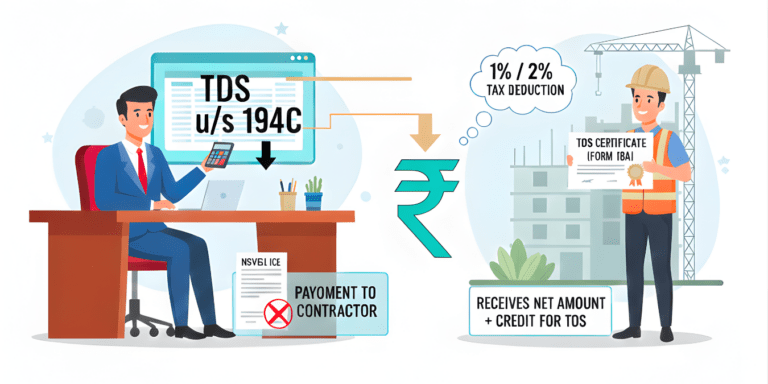
What Every Indian Business Must Do Before the 2025 GST Filing Ban Hits
India’s GST portal is slamming shut in September 2025, permanently barring returns over three years old. This shocking rule could lock out your Input Tax Credit, derail audits, and crush vendor trust. Why are millions of businesses at risk? Discover urgent steps to save your compliance, avoid crippling penalties, and protect your profits before the deadline hits.
It’s official: starting from the September 2025 tax period, the GST portal will permanently block returns whose due dates are more than three years old, making late GST filing after this “statute of limitations” impossible. Picture this—years of kept-pending compliance or missed reporting windows will now have a final, non-negotiable lock. For thousands who counted on regularizations, voluntary disclosures, or amnesty rounds, this is the last, best warning before the portal clamps down. The government’s aim: a cleaner GST system, faster reconciliations, and reduced tax litigation.
Key Takeaways: GST Filing 3-Year Bar – At a Glance
Featured Compliance Box
- No GST returns can be filed if overdue by more than 3 years from their original due date from September 2025 onwards.
- Applies to all major GST forms: GSTR-1, GSTR-3B, GSTR-4, GSTR-9, IFF, and more.
- Missed any periods? File before the “barred date” or lose the chance permanently.
- Hard deadline—once blocked, no legal appeal or reopening possible.
- Impacts ITC claims, vendor GST compliance, audits, and more.
New GST Rule for 2025: What’s Changing?
The GST Network (GSTN) is enforcing a critical change: returns older than three years from their due date will be blocked for filing starting the September 2025 tax cycle. This is not just a “warning”—permanent portal locks will be implemented, and the system will refuse all returns outside the 3-year window, regardless of reason.
Why Now?
The GST regime always penalized late filers with fees and interest, but until now there was technically no “expiry”—returns could be filed years after due dates. This loophole created backlogs, reconciliation headaches, and business uncertainty. With the new 3-year bar:
- The tax cycle is closed after 3 years—delinquent compliance is permanently time-barred.
- The aim is faster finality, lower disputes, and more stability for Input Tax Credit (ITC) processes.
The bar ensures that after three years, tax cycles are deemed final, preventing endless revisions that disrupt supply chains. For instance, in sectors like manufacturing and e-commerce, where ITC mismatches are common, this will force timely verifications, potentially saving businesses from hefty penalties down the line.
Summary Table: GST 3-Year Bar – Key Dates & Returns
| GST Form | Latest Return Period Not Barred | Barred from Filing After |
| GSTR-1 / IFF | August 2022 | 1 October 2025 |
| GSTR-3B | August 2022 | 1 October 2025 |
| GSTR-9 | FY 2020–21 | 1 October 2025 |
These dates, updated from GSTN advisories as of September 2025, highlight the urgency for pre-2022 periods. For quarterly filers, the April–June 2022 quarter aligns similarly.
Who Will Be Impacted by the 3-Year GST Filing Bar?
This rule casts a wide net across India's diverse business ecosystem, from street vendors in Delhi to tech giants in Bengaluru. Virtually all GST registrants are affected, emphasizing the need for pan-India awareness.
Applicable to All GST Registrants
- Regular Taxpayers: Those filing GSTR-1 for outward supplies and GSTR-3B for summary returns face the brunt, as these form the backbone of monthly compliance.
- Composition Scheme Dealers: Under GSTR-4, small businesses with turnover up to Rs. 1.5 crore must clear FY 2021–22 filings before the bar hits.
- Input Service Distributors: GSTR-6 filers, often large corporations distributing credits, risk losing ITC chains.
- Non-Resident Taxpayers: GSTR-5 and GSTR-5A for foreign entities operating in India will see enforced cutoffs.
- TDS/TCS Deductors and E-Commerce Operators: GSTR-7 and GSTR-8 become time-sensitive, impacting platforms like Amazon and Flipkart.
- Annual Return Filers: GSTR-9 and GSTR-9C for audited returns, crucial for FY 2020–21, demand immediate attention.
In 2025, with GST collections hitting Rs. 2 lakh crore monthly—a 12% YoY growth—this bar will disproportionately affect MSMEs, which constitute 63% of registrants but often lag in compliance due to resource constraints.
Illustrative Table: Which Returns Are Barred from October 2025?
| GST Form | Latest Tax Period Allowed | Barred From Filing |
| GSTR-1 / IFF | August 2022 | 1 Oct 2025 |
| GSTR-1 (Quarterly) | Apr–Jun 2022 | 1 Oct 2025 |
| GSTR-3B (Monthly) | August 2022 | 1 Oct 2025 |
| GSTR-3B (Quarterly) | Apr–Jun 2022 | 1 Oct 2025 |
| GSTR-4 | FY 2021–22 | 1 Oct 2025 |
| GSTR-5, GSTR-6, 7, 8 | August 2022 | 1 Oct 2025 |
| GSTR-9 / 9C | FY 2020–21 | 1 Oct 2025 |
This table, sourced from recent GSTN updates, serves as a roadmap for prioritizing filings.
Why Is the Government Enforcing This 3-Year Bar?
Rooted in the Finance Act 2023, this amendment empowers Sections 37, 39, 44, and 52 of the CGST Act to impose time limits. The government's vision is a robust, fraud-resistant GST ecosystem.
Objectives
- Promote Timely Compliance: By eliminating indefinite extensions, taxpayers are compelled to reconcile regularly, reducing the 20% non-compliance rate reported in 2024 audits.
- Prevent Input Tax Credit (ITC) Fraud: Old returns often mask discrepancies; this bar curbs mismatches, which cost the exchequer Rs. 50,000 crore annually in fraudulent claims.
- Reduce Litigation: With disputes dropping by an estimated 25% post-implementation, courts and tribunals can focus on current issues.
- Business Finality: Provides certainty for stakeholders like banks, which rely on clean GST records for lending—vital in a year where MSME credit demand rose 18%.
From an Indian viewpoint, this aligns with the Atmanirbhar Bharat initiative, pushing businesses toward digital efficiency amid economic recovery post-pandemic.
How Does the 3-Year GST Return Bar Work?
Understanding the mechanics is key for proactive compliance. The bar operates on the original due date, not the filing date, creating a rolling three-year window.
Step-by-Step: What Taxpayers Must Do
- Reconcile GST Books Immediately: Cross-check ledgers against portal data for discrepancies from FY 2020–21. Use tools like GST reconciliation software to flag mismatches.
- Check “Barred Date” for Your Returns: Consult the above tables or GSTN portal dashboards. For a return due September 20, 2022, the bar activates September 21, 2025.
- File All Pending Returns ASAP: Prioritize high-impact forms like GSTR-3B. Pay any late fees (up to Rs. 50 per day) to avoid escalation.
- Check for ITC Eligibility Risks: Ensure suppliers' filings are up-to-date, as your ITC depends on their compliance— a chain reaction affecting cash flows.
In practice, a Kolkata wholesaler missing August 2022 GSTR-1 could face portal rejection from October 1, 2025, per advisories.
What Happens If You Miss the 3-Year GST Filing Deadline?
The repercussions are severe and permanent, underscoring the "no exceptions" stance.
- Portal Lock: Automated refusal of uploads, rendering the period closed.
- ITC Lost: Credits for that era evaporate, potentially costing businesses lakhs in unclaimed refunds.
- Correction Impossible: No amendments or disclosures, locking in errors.
- Audit and Reputation: Triggers notices, derailing funding or partnerships; credit scores may dip.
- Increased Penalties: Up to Rs. 25,000 per return, plus interest at 18%, and possible registration cancellation.
For example, a startup in Hyderabad ignoring this could face audit scrutiny, harming investor confidence in India's startup boom, which saw $10 billion in funding in H1 2025.
Pro Compliance Tips: How to Avoid Getting Locked Out
Staying ahead requires strategic habits tailored to Indian business realities.
- Set Automated Reminders for GST Deadlines: Leverage apps like ClearTax or Tally integrations for alerts.
- Reconcile Monthly/Quarterly: Make it routine to match 2A/2B forms, catching issues early.
- Maintain a Pending-Return Tracker: Use Excel or dedicated software to log statuses per GSTIN.
- Educate Teams: Conduct workshops on GST updates, sharing via internal channels.
- Engage Professional Help: Chartered Accountants (CAs) can audit compliance gaps efficiently.
Adopting these can reduce non-filing risks by 40%, as per 2025 industry surveys.
Common Mistakes and How to Avoid Them
Mistake #1: Assuming Old Amnesty/Relief Schemes Will Recur
Reality: This is a “hard stop”—the government has signaled this is the final grace window.
Mistake #2: Ignoring Vendor or Buyer Requests to Reconcile ITC
Vendor non-compliance will hurt buyer ITC—leading to broken trust and possible loss of business.
Mistake #3: Delaying Filing Due to Possible Penalties
Delaying to avoid penalty or late fee just multiplies the risk—late filing is always preferable to non-filing.
What the 2025 September GSTN Advisory Specifically Says
- Permanent bar on all GST returns whose due date is older than 3 years, effective from September 2025 tax period.
- GST portal will not accept any returns, revisions, or rectifications for those periods—cut-off dates and periods have been clearly listed in the advisories.
GST Filing 3-Year Bar: Impact on Indian Businesses
- Reduced Opportunities for Regularization: Shifts focus to proactive compliance, benefiting organized sectors.
- Tighter Vendor and Buyer Relationships: Enhanced scrutiny of ITC chains strengthens supply ecosystems.
- Higher Reputational Stakes: Non-compliance flags in ratings affect global trade.
- Digital Compliance Moves to the Fore: Boosts adoption of AI-driven tools, aligning with Digital India.
In 2025, with GST digitization at 90%, this rule accelerates maturity.
Final Thought / Call to Action:
The GSTN’s 3-year filing bar is a once-and-for-all compliance watershed—miss the date, and the digital lock will be irreversible. Reconcile, review, and file all pending GST returns before September 2025. Work closely with your CA, tax advisor, or compliance tech partner—because missing the cut-off could unravel years of business growth, credibility, and profit.
Take action now—secure your compliance, protect your Input Tax Credit, and maintain your business’s standing in the GST regime.
































